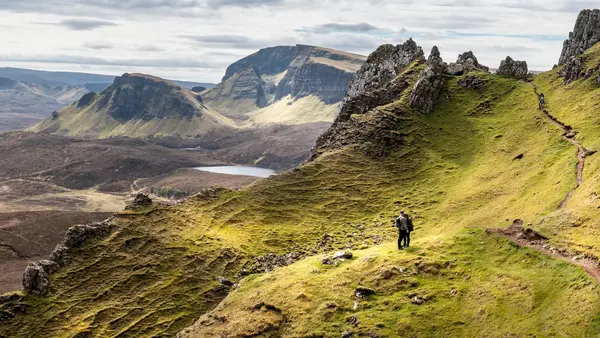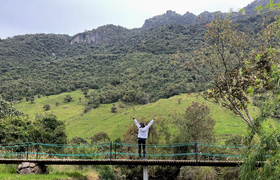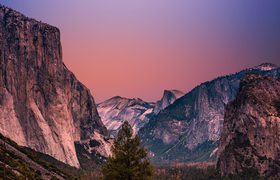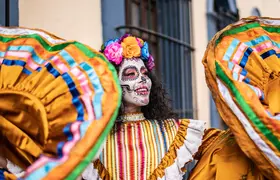
Lochs and legends: best of Scotland's activities and outdoors
Discover Scotland’s best experiences, from exploring ancient castles and misty lochs to tasting whisky where it's made
Stories from the past, rich cultural experiences, and whisky are all things that can be enjoyed in scenic Scotland. Varied landscapes set the scene for all sorts of adventures, from hiking alongside lochs to breezy urban adventures. Whether you’re looking for new ways to appreciate the outdoors or lean into your travel interests on your next trip, here are the best activities and outdoor adventures in Scotland.
Take a hike in Scotland's great outdoors
Take it all in on foot. Push your mental and physical limits or take it steady on a sporadic stroll. Whatever your style, there are 282 Munros (mountains taller than 915m (3,000 ft)), 790 islands, and 18,000km (11,185 mi) of coastline waiting to be explored.
Laced with hiking trails, the Cairngorms is the United Kingdom's biggest national park, covering 6% of Scotland’s land mass and spanning 4,528 sq km (1,749 sq mi). Among the area’s 55 Munros are deep river valleys, native Caledonian pine forests, and hidden lochans (small lakes). Keep an eye out for fluffy highland cows and a boulder marking the centre of Scotland on your way around.
Varied terrain, year-round activities and a strong heritage in pursuits out in the elements have earned Fort William recognition as the outdoor capital of the UK. Surrounding this highland town are untamed glens, huge lochs, and plenty of mountains, including Britain’s highest, the 1,345m (4,413 ft) Ben Nevis. High-altitude thrills and silent wilderness are easy to find here.
Arguably, the most daring mountaineering route in the UK is found on the Isle of Skye. An exposed knife-edge traverse makes the Cullin Ridge a mental challenge as well as a physical and technical one. At the other end of the island, north of Portree, the Old Man of Storr’s distinct dagger-shaped rocky pinnacle cuts through the skyline. The Misty Isle’s unusual natural spectacles make even the shortest of strolls worthwhile for the views, such as the Fairy Pools, Fairy Glen, and the dinosaur footprints at An Corran.

Experience it for yourself on: Highlights of Scotland
Stroll Scotland's cities
Hilltop splendour is a common theme in Edinburgh. An uphill slog up the 251m (822 ft) Arthur’s Seat is worth the huffing and puffing, and at the top, you're treated to unparalleled views of the city while standing on the edge of an ancient, extinct volcano. Time it with good weather and clear skies to reveal vistas all the way to the River Forth and the North Sea. On top of Calton Hill is a UNESCO World Heritage Site, an open-air gallery of the capital’s most impressive monuments. Perhaps the most eye-catching of all, rising above the rooftops on a 135m (443 ft) rocky plinth is Edinburgh Castle, where you can trace the route of monarchs along the Royal Mile to Holyrood Palace.
The cultural capital of the Scottish Highlands, Inverness, is a trove for arts, music, and kilt-making. Themed trails through the city take travellers on a circuit around the Caledonian Canal paths, to the battlefields of Culloden, and along parts of the Great Glen Way. In the city centre, on the east side of the river, the red sandstone Inverness Castle marks a good starting point for walking the historic trail. A cluster of interesting buildings resides around here, like an old Gaelic church, the Victorian Market, and a 19th-century Egyptian-influenced library.

Experience it for yourself on: Journeys: Discover Scotland
Taste Scottish whisky
Flavoured by the landscape, Scotland’s most beloved tipple is best understood by looking at a map. While no single whisky region has a uniform taste, there are similarities in the distilling process and character. The most obvious distinction is between Highland whisky and Lowland whisky, split by the Highland Line, running from the Firth of Clyde to the Firth of Tay.
Below the line, the Lowlands are best known for blends of single malt whisky with spirits made from less-expensive grains, such as wheat or corn. The Highlands are split into various subregions. Islands whisky is where it all began, on the Western Isles in the 15th century. Cooler temperatures brought by the Atlantic breeze create optimum conditions for slow, gentle aging in oak barrels. World-renowned producers such as Talisker and Highland Park fall within this category, which is heavily influenced by the ocean and often smoky.
Speyside whisky, often described as fruity and luxurious in the mouth, is made around the salmon-filled River Spey and is the densest whisky-producing area in the world. You can easily walk between a handful of the distilleries on part of the 96km (66 mi) Speyside Whisky Trail. Within 13km (8 mi) of each other along the riverside path are Glen Grant Distillery, Speyside Cooperage Distillery, and Glenfiddich Distillery. If three tasting sessions would knock you off your feet, at Blair Athol Distillery, you can tie together a tipple tasting experience with a Victorian history and heritage walk around Pitlochry. As well as seeing how the whisky here is influenced by an ancient water source flowing through the grounds, there’s also an 18th-century castle nearby and the narrow Loch Tummel.

Explore the Scottish Isles
With a catalogue of more than 900 islands in Scotland, most are untouched, uninhabited, and wild. In the seas surrounding the mainland are some of the most remote parts of Scotland, home to tight-knit communities that are proud of their heritage and traditions. Among the rugged, dramatic landscapes, you’ll also find some of Britain’s oldest history and richest wildlife havens.
Whispers of myth, legend, and folklore can be heard all over the Scottish Isles, much of which is said to have been formed by giants. Herman and Saxa, a bickering pair who threw rocks at each other, are responsible for the bouldered outcrops and sunken skerries around Unst in Shetland. Orkney’s enormous standing stones of the Ring of Brodgar are giants that were petrified by the sun’s rays while they danced. The former home of a giant can also be seen on Staffa, known as Fingal’s Cave.
Pilgrims have journeyed to the tiny island of Iona for 1,500 years for its spiritual significance. Hidden at the top of this sacred isle, on the highest hill, is the secret to eternal youth. There’s a small natural pool with healing powers, according to Celtic myth, after the water was blessed by a saint. Fairies once lived on the Isle of Skye, mysterious Blue Men of Minch in the sea between the Outer Hebrides and the mainland, and shapeshifting seals known as Selkies in the Northern Isles.

Experience it on: Expedition Through the Scottish Isles: Where Land Meets Legend
Get a deeper look at lochs
Stone carvings from AD 500 show the first recording of the mythical monster, Nessie, who hides in a loch with more water than all of the lakes in England and Wales combined. At one end of the 37km-long (23 mi) Loch Ness is a cultural hub overflowing with museums and galleries, the city of Inverness. From here, hop on a boat to Fort Augustus to delve into clan ancestry, stopping at waterside 13th-century Urquhart Castle along the way.
In a corridor of evergreens and ferns through the southerly mountains, Loch Lomond is a true beauty of Scotland and a thriving wildlife area with otters, golden eagles, and red squirrels. Miles of walking trails lead to waterfalls, hilltop viewpoints, and rocky peaks. On the water, you can get a better look at some of the 22 islands and 27 islets by kayak, paddleboard, or boat.
Find ancient history in the water of Loch Tay. About 2,500 years ago, people lived in round timber-built houses that hovered above the loch on wooden stilts. Only a reconstruction of these crannogs can be seen standing today, but nearly 20 of them have been found beneath the water.

Experience it on: Journeys: Discover Scotland
Follow in the footsteps of Vikings
A 24m (79 ft) oak, hand-built Viking Gostad ship sits on the northernmost inhabited island of the UK, overlooking the North Atlantic. More than 322km (200 mi) from the mainland, on the island of Unst, this replica ship marks the spot where Vikings are believed to have first landed when arriving on their voyage from Norway. Proud of its origins, the Shetland archipelago still has a strong Norse influence that's seen in everything from the music, place names, and the well-preserved landmarks, such as the Viking longhouses of Jarlshof.
An 88.5km (55 mi) trail exploring the legacy of St Magnus on mainland Orkney leads you in the footsteps of Vikings. At low tide, the pathway to the Borough of Birsay is revealed, where the remains of a Viking village and a carved runic stone still stand. More Viking engravings can also be seen on the Neolithic Maeshowe chambered tombs, which were built earlier than the Pyramids of Giza.

Experience it for yourself on: In the Wake of the Vikings: Orkney, Shetland & the Faroe Islands
Packing tips for Scotland
Your number one essential is midge repellent and bug-proof face nets if you’re visiting between May and September. These biting pests linger around still water, such as boggy areas and lochs, but they can often be avoided in cities or windy areas like the coast. Rain showers can happen at any time of year, so pack some waterproofs, which are also useful for blocking out the breeze in windy areas.
Sturdy boots are always recommended, especially for hiking holidays in Scotland, because they give you extra protection on the trails and keep your toes dry in boggy areas. Having a map is also a good idea because phone signal often drops out in remote areas.
Scotland seasons and weather
Scotland changes dramatically with the seasons, wearing golds and reds in autumn, snow coverage in winter, multi-coloured wildflowers in spring, and purple heather in summer. One thing that’s year-round is rain. Even in summer, you can expect the odd rain shower, while the average temperature sits between 15°C (59°F) and 18°C (64°F). Autumn often stays fairly mild. Through October and September, the temperature lingers around 15°C (59°F). January is the wettest month, and at this time of year, the thermometer drops to averages of –2°C (28°F) and 5°C (41°F), warming to 8°C (46°F) to 13°C (55°F) in spring.




